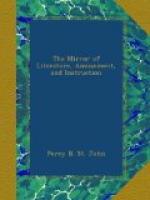it was always thought to exert an influence over his
future destiny. Such was the origin of many of
our later superstitions, which “grew with their
growth, and strengthened with their strength,”
till the more extensive introduction of the art of
printing partly dissipated the illusion. It has
been remarked, therefore, that the existence of the
parent stock of the subject more immediately under
our consideration, witchcraft, may be traced to a
very remote period indeed. It is, however, needless
to enter into any remarks on those witches mentioned
in the Scriptures. The earliest dabbler of the
genus, as a contemporary writer observes, is
said to be Zoroaster, thought to be the king of the
Bactrians, who flourished about 3,800 years ago, or
A.M. 2000. He is supposed to have been well versed
in the arts of divination and astrology, and was the
origin of the Persian magi. “At his birth,”
remarks an old writer, “he laughed; and his
head did so beat, that it struck back the midwife’s
hand—a good sign of abundance of spirits,
which are the best instruments of a ready wit.”
The magi in Persia, the Brahmins in India,
the Chaldae in Assyria, the magicians of Arabia, the
priesthood of Egypt, Greece, and Rome, and the Druids
of Britain, were all members of a class which comprised
astrology, omens, divination, conjuration, portents,
chiromancy, and sorcery; and all united in the pursuit
of enslaving mankind for the purposes of gain and
power, with artfully devised schemes, and a skilful
series of impostures; and we can easily imagine the
influence they must have exercised over the minds of
their proselytes, when we bear in mind the effect
produced by similar contrivances in later days.
The enchantress Theoris of Athens seems to have been
the first witch that had recourse to charms. Demosthenes
uses the terms both of witchery and imposture in speaking
of her. This witch was put to death by the Athenians—an
accomplice having displayed to them the charms, &c.,
by which she wrought her miracles. Our Saviour’s
words, that faith can remove mountains, are
applicable particularly to the supposed powers of
witchcraft; and the influence of charms and amulets
in averting disease is well known. We have alluded,
in our first paper, to the trial of Rose Cullender
and Amy Duny, at Norwich, for witchcraft; and we now
give the speech of Sir Thomas Browne, the celebrated
physician of that period, (1664,) to whom, in consequence
of defect in the proof, the case was referred, which
was the cause of their conviction. Sir Thomas
Browne offered it as his opinion, “that the
devil, in such cases, did work upon the bodies of men
and women, upon a natural foundation, (that is) to
stir up and excite such humours superabounding in
their bodies to a great excess, whereby he did, in
an extraordinary manner, afflict them with such distempers
as their bodies were most subject to, as particularly
appeared in the children of Dorothy Dunent, (one of
the indictments against the prisoners being for their
bewitchment;) for he conceived that these swooning
fits were natural, and nothing else but that they
call the mother, but only heightened to a great
excess by the subtilty of the devil co-operating with
the malice of these, which we term witches, at whose
instance he doth the villanies.”




